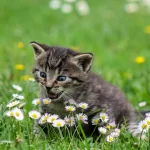Cats are territorial, and they instinctively take care of any competitor within their territory. While they might not eat rabbits, cats will attack them to protect their sphere of influence. Cats will also kill rabbits or deer entering their territory or running through their yard. This informative blog post will detail how you can keep cats away from rabbits in your garden.
There are several methods for keeping cats away from rabbits in your garden, depending on the size of your yard and how much you want to invest in protection devices.
There are five primary methods for keeping cats away from rabbits in your garden. Remember that each of these options will have its pros and cons. Also, remember to figure out whether you want to train them, buy a product or make a homemade device.
If you want to train your cat not to bother the rabbit in its territory, here’s what you can do:
First and foremost: Be consistent in training and use positive reinforcement (never use negative reinforcement like hitting the animal). The cat will learn simply by associating pain or discomfort with certain behaviors.
Reward the cat with a treat every time it stays away from the rabbit and does not bother it. You can buy cat treats at your local supermarket, but you can also make your own: take some tuna and some bread and mix them.
The most effective and cost-effective cat-safe barrier is a simple fence. A good wall can quickly be built using wire and plastic sheeting, and it will protect your rabbit from any danger from an unwanted guest. You can keep cats out of your garden by creating a large enclosure with wire fencing.
The fencing should be fitted tight enough to keep animals outdoors but loose enough to allow animals to come in and out as you see fit. Place the fence as far as possible away from the rabbit’s house so that no one gets accidentally hurt when entering or leaving the area where your rabbit is kept.
If your yard or garden is large, you might want to invest in a cat fence. Cat fencing is essentially a wire barrier that provides a safe and secure space for your cat and prevents it from crossing into where your rabbit is kept. You can buy cat fences at most pet stores, but build your own using aluminum fencing and hardware cloth. Making your cat fence can be much cheaper, and it allows you to customize the wall to fit your yard.

If you want to build a cat-free zone in your yard or garden, but you don’t have enough money for proper fences, you can make several devices that will help keep cats away from your rabbit. One option is to use an old freezer’s top as a barrier between the cat and the rabbit’s cage.
Note: This is only a temporary solution – your rabbit will eventually figure out how to get out of the enclosure without breaking anything, and you will need to make a new box every week. Also, young rabbits are more likely to use these boxes/sections in your yard.
You can buy products specifically designed to keep cats away, but plenty of other options around the market. You can buy products containing a small amount of the rabbit’s urine or faeces, which will keep felines away from your pet. You can also put rabbit medications in the area where your pet rabbit is held, especially if your cat often invades or enters your yard or garden.
There are two primary reasons:
1) Rabbits and cats can be very different and challenging to keep together. The most frequent problems you might encounter include:
· Aggressive behavior between the two pets
· Difficulty keeping them still as they fight over the same resources
· Allergies develop in one or both animals due to constant
2) Rabbits and cats can produce completely incompatible litters due to their reproductive systems. This leads to many unwanted babies because it’s hard for a rabbit owner to know who sired any given baby. Because many of the rabbits and cats in the pet trade are not spayed/neutered, it’s difficult to predict what will happen when they’re placed together.

1) Rabbits and cats are two very different animals, so they’ll react differently to the same stimuli. For example, rabbits cannot communicate with humans verbally, so “pestering” one is not likely to work.
2) Rabbits and cats are similar in size (typically), and they can be unpredictable due to their lack of verbal communication, even more so if they’re babies.
3) Rabbits and cats may be more aggressive than you want them to be due to their reproductive systems; many people end up with an unhealthy number of unwanted kits–most of whom died shortly after birth.
4) Keeping rabbits and cats together can be tricky if you don’t know their behavioral patterns. While it might work out just fine, there’s also a high risk of injury and unhappiness for all involved.
5) Rabbits and cats live in different worlds: the rabbit’s world is one of the smells, the sound of feet, etc., while the cat may rely on hearing more than sight to get around. Unless they’re both acclimated to each other (from a very young age), they will probably communicate differently, making them uncomfortable or nervous about interacting with each other.
6) Rabbits are generally more sensitive to the cold. If your pet is kept indoors, they should remain protected from extreme temperatures throughout the year. If you own an indoor/outdoor cat, keeping them adequately warm in the winter or summer may be difficult.
7) Many different things can be problematic for rabbits, including fungal infections, stomach viruses, parasites, etc. Cats are pretty prone to them too. If not kept up on proper care, this can lead to illness or even death.
8) Most people don’t expect their pets to be “wet.” Rabbits cannot sweat due to their lack of lungs; this makes it hard for them to regulate their body temperature. If kept with a cat that requires extensive grooming (which is very common–cats groom themselves), it can be difficult for the rabbit owners to get their pet healthy without compromising the cat’s skin.
9) Rabbits, like most animals, do not know their strength. You can easily injure or kill your rabbit or cat when trying to play with them. Also, you might accidentally hurt the cat with a natural (or perceived) threat (rabbit rearing up and striking out at it), which can provoke aggression in either animal.
10) Rabbits and cats tend to be very delicate; almost every rabbit gets sick or injured easily due to its small frame. If one of these pets is in pain (heat stroke, for example), the other will likely suffer.




